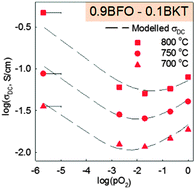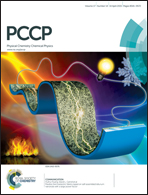Electrical conductivity and thermopower of (1 − x) BiFeO3 – xBi0.5K0.5TiO3 (x = 0.1, 0.2) ceramics near the ferroelectric to paraelectric phase transition
Abstract
Ferroelectric BiFeO3 has attractive properties such as high strain and polarization, but a wide range of applications of bulk BiFeO3 are hindered due to high leakage currents and a high coercive electric field. Here, we report on the thermal behaviour of the electrical conductivity and thermopower of BiFeO3 substituted with 10 and 20 mol% Bi0.5K0.5TiO3. A change from p-type to n-type conductivity in these semi-conducting materials was demonstrated by the change in the sign of the Seebeck coefficient and the change in the slope of the isothermal conductivity versus partial pressure of O. A minimum in the isothermal conductivity was observed at ∼10−2 bar O2 partial pressure for both solid solutions. The strong dependence of the conductivity on the partial pressure of O2 was rationalized by a point defect model describing qualitatively the conductivity involving oxidation/reduction of Fe3+, the dominating oxidation state of Fe in stoichiometric BiFeO3. The ferroelectric to paraelectric phase transition of 80 and 90 mol% BiFeO3 was observed at 648 ± 15 and 723 ± 15 °C respectively by differential thermal analysis and confirmed by dielectric spectroscopy and high temperature powder X-ray diffraction.


 Please wait while we load your content...
Please wait while we load your content...